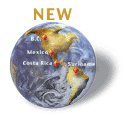|
|||||||||||||||||
|
|
|
||||
Sara Kreek MineIntroduction: Sara Kreek is the only legally-operating gold mine in the Republic of Suriname, South America. Production in 2001 was approximately 10,000 oz. gold from the small, open pit placer mine and gravity recovery systems. A second high grade, open pit lode mine is also ready for development, subject to financing. The Sara Kreek property produced over 500,000 oz. gold historically and has the potential for additional discoveries in the million oz. plus range. Location and Access: East central Suriname, 160 km south of Paramaribo, the capital city, accessible by charter aircraft to a 1500 ft. airstrip on the property or by boat across Van Blommestein Lake (a large, man-made lake for a hydroelectric project), then by truck on the property access road. Property Description:
The Sara Kreek Placer mine currently operates at a small profit notwithstanding the low gold price. Canarc recently completed a feasibility study recommending commercial production from one of the several lode prospects on the property. Management is now seeking project financing for the new DP lode mine. Mining History: Gold production
was first recorded from Sara Kreek in the late 1800’s, when English
and Dutch companies exploited the alluvial deposits. At their peak, several
large dredges were in operation and a 200 km long narrow gauge railway
was built from Paramaribo to Sara Kreek, to service the hundreds of families
living there. The gold fields produced over 500,000 oz. gold, then fell
dormant for 50 years, until Suriname Wylap Development Corp. modernized
the placer mines and operated briefly in the late 1980’s. Canarc
acquired its property interests in 1993 and funded the re-commencement
of placer gold mining in 1995. . Gold production for 2001 was 10,000 oz.,
and the mine operated at around break-even at the recent low gold prices.
Recent Work: Exploration to seek out the underlying lode sources to the placer gold began in earnest in 1994. In the past 5 years, Canarc has completed 20,000 soil and silt samples, hundreds of deep auger holes, several kms of machine trenching and 28 diamond drill holes at a cost exceeding US $4 million. Most recently, Canarc completed a feasibility study on the DP zone that recommends commercial production from a small, high grade, open pit to produce 13,500 oz. at a cash cost of US $62 per oz.! Regional Geology: The Guyana Shield became the focus of exploration interest in the past six years as a result of the 12 million oz. Las Cristinas gold discovery by Placer Dome in Venezuela, as well as the commencement of commercial production by Cambior at the 4 million oz. Omai gold deposit in Guyana, the only modern gold mine operating throughout the Guyana Shield. Both of these gold discoveries have strong affinities to the porphyry gold, bulk tonnage, open pit model. In addition, these lower Proterozoic greenstone belts are prolific for high grade, shear-hosted gold deposits elsewhere in the world, such as the 50 million oz. Ashanti mine in Ghana. The gold prospects at Sara Kreek exhibit shear-hosted or porphyry-type mineralization related to quartz-carbonate veins or stockworks within volcano-sedimentary greenstone belts intruded by tonalite-diorite plutons along major crustal breaks within the Guyana Shield. Deposit potential here is one million ounces, plus. Property Geology: All of the known gold prospects fall along a north trending greenstone belt of meta-volcanic and meta-sedimentary rocks, crosscut by northeast and northwest trending structures. Mineralization also appears to be related to late-stage quartz-feldspar porphyry or diorite intrusions. Gold is associated with pyrite, chalcopyrite and other sulfide minerals in quartz-carbonate veins, shears and stockwork zones.
Canarc found multiple soil anomalies by reconnaissance sampling, including two main mineralized shear zones that extend for 7 km and 6 km respectively. Follow-up deep augering, machine trenching and diamond drilling has confirmed high grades over mineable widths in four gold prospect areas. Trench results include 13.6 gpt over 10 m, 2.3 gpt over 40 m and 1.2 gpt over 160 m. Drill intersections include 7.0 gpt over 13.5 m, 2.9 gpt over 16.6 m and 5.9 gpt over 10.7 m. Reserves: DP mine reserves are 16,000 oz. gold contained in 65,000 tonnes soft saprolite ore grading 7.5 gpt, still open in 3 directions. No reserves are estimated for the placer mine but there are several kilometres of known gold-bearing creek gravels that should support many years of placer mining. Mining: DP mine methods are shallow open pit truck and shovel operation, no drilling or blasting, 8:1 strip ratio, 8½ month mine life. The placer mine is an open pit, excavator and hydraulicing operation. Processing: DP mine process returns 85%+ recovery using gravity methods. The ore is cleaned and screened in a trommel, reduced to ¼ inch in a crusher, ground to 80%-200 mesh in a ball mill, and the gold is separated using Falcon concentrators and a shaking table. A bulk sample for metallurgical testing consistently returned higher grades than the channel sampling. The placer mine recovers coarse gold only with sluice boxes. Exploration Target: The exploration target at Sara Kreek is shear-hosted gold deposits of several million tonnes containing several million oz. gold to 300 m depth. The two main gold mineralized shear zones have been traced semi-continuously over 13 km of combined strike length on the property. Production Model: Base case production for the
DP mine is 13,600 oz. over an 8½ month period, net capital costs
estimated at US $1.05 million and total operating costs come in at US
$62 per oz! Similar positive exploration results were found at the ED,
WP and PP prospects, leading management to believe that production will
come from several high grade open pits that could eventually coalesce
into one large lode gold mining operation with million oz. plus potential. |

|
|||
disclaimer |
||||





 Significant
Results:
Significant
Results: